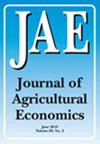Sustainability Effects of the Uptake of More Grass‐Based Feeding Practices: Evidence From Sweden
IF 4.2
2区 经济学
Q1 AGRICULTURAL ECONOMICS & POLICY
引用次数: 0
Abstract
We examine the effects of the uptake of grass‐based feeding practices on the economic, environmental, and social dimensions of farm sustainability. More specifically, we analyse the predictive effects of an increase in grassland or ley area on farm net income, total working hours, and fertiliser expenditure. Our analysis utilises farm‐level data from Swedish dairy farms spanning the period 2002–2021. Drawing on a directed acyclic graph (DAG), we assess both the average and distributional effects using panel regression with fixed effects and penalised panel quantile regression methods, respectively. Our results show that an increase in either grassland or ley area is associated with a decrease in both farm net income and fertiliser expenditure, alongside an increase in total working hours on average. Our distributional analysis further indicates that these effects vary across the quantile distribution of the outcome variables. Finally, the results show that an increase in either grassland or ley area leads to a reduction in milk yield, feed cost and the cost of veterinary services. Overall, our findings highlight the trade‐offs associated with farmers' transition towards the uptake of more grass‐based feeding practices and the policy implications.更多以草为基础的喂养方式的可持续性影响:来自瑞典的证据
我们研究了以草为基础的饲养方式对农场可持续性的经济、环境和社会层面的影响。更具体地说,我们分析了草地或草地面积增加对农场净收入、总工作时间和肥料支出的预测效应。我们的分析利用了2002年至2021年期间瑞典奶牛场的农场级数据。在有向无环图(DAG)上,我们分别使用固定效应的面板回归和惩罚面板分位数回归方法来评估平均效应和分布效应。我们的研究结果表明,草地或草地面积的增加与农场净收入和肥料支出的减少以及平均总工作时间的增加有关。我们的分布分析进一步表明,这些影响在结果变量的分位数分布中有所不同。最后,结果表明,草地或草地面积的增加都会导致产奶量、饲料成本和兽医服务成本的降低。总体而言,我们的研究结果强调了与农民向更多以草为基础的喂养方式过渡相关的权衡及其政策影响。
本文章由计算机程序翻译,如有差异,请以英文原文为准。
求助全文
约1分钟内获得全文
求助全文
来源期刊

Journal of Agricultural Economics
管理科学-农业经济与政策
CiteScore
7.90
自引率
2.90%
发文量
48
审稿时长
>24 weeks
期刊介绍:
Published on behalf of the Agricultural Economics Society, the Journal of Agricultural Economics is a leading international professional journal, providing a forum for research into agricultural economics and related disciplines such as statistics, marketing, business management, politics, history and sociology, and their application to issues in the agricultural, food, and related industries; rural communities, and the environment.
Each issue of the JAE contains articles, notes and book reviews as well as information relating to the Agricultural Economics Society. Published 3 times a year, it is received by members and institutional subscribers in 69 countries. With contributions from leading international scholars, the JAE is a leading citation for agricultural economics and policy. Published articles either deal with new developments in research and methods of analysis, or apply existing methods and techniques to new problems and situations which are of general interest to the Journal’s international readership.
 求助内容:
求助内容: 应助结果提醒方式:
应助结果提醒方式:


